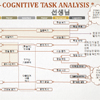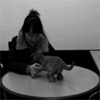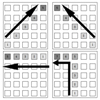Human-Robot Interaction, Haptics, Misc.
Human-Robot Interaction
|
| Robot-based Imitation Intervention for Children with Autism Spectrum Disorders (ASD), 2012 - 2013 |
 |
Overview
Autism Spectrum Disorders (ASD) is a developmental disorder which causes the lack of social interaction and communication skills. The recent research revealed that one out of 34 children in Korea was diagnosed with ASD. In spite of this high prevalence rate, there are not enough institutions which provide care and interventions for autistic children. Therefore, this research investigates the development and the use of an interactive robot for autistic children.
Additional information
- Hwang, J., Kim, M. G., & Cho, K. (2013). Developing interaction scenarios of robot-mediated imitation training for children with Autism Spectrum Disorders. In 2013 IEEE RO-MAN, pp. 616-620. IEEE.
[Link]
- Hwang, J., Kim, M.-G., Cho, K. (2013). Development of a Robotic Platform for Intervention for Children with Autism Spectrum Disorder. HCI Korea 2013 (Accepted).
|
|
Human-Robot Interaction
|
| Development of HRI Technologies for Human-friendly Robot Service Environments, 2012 - 2013 |
 |
Overview
Research Project with the Ministry of Knowledge Economy (MKE), Korea
- Analyzing 1:1 human-human interaction in the tutoring context (video-coding and task analysis)
- Developing service scenarios and writing pseudo-codes for a robot tutor
Additional information
- Hwang, J., Kim, M.-G., Cho, K. (2013). Development of a Robotic Platform for Intervention for Children with Autism Spectrum Disorder. HCI Korea 2013 (Accepted).
|
|
Human-Robot Interaction
|
| Recognizing User's Personality Traits based on Tactile Interaction Patterns with a Robot, 2011 - 2012 |
 |
Overview
Personality analysis has been an important topic in psychology and human-robot interaction (HRI) as well. Main theme of this research is to explore the relationship between individualĄ¯s personality traits and tactile interaction patterns with a robot. A sociable robot Pleo was used in the experiment. The tactile interaction patterns of the participants with the robot were video-recorded and analyzed. The result showed that individualĄ¯s personality traits could be inferred based on the tactile interaction patterns with a robot.
Additional information
- Hwang, J., & Lee, K. C. (2015). Exploring the effect of a userĄ¯s personality traits on tactile communication with a robot using Bayesian networks. Interaction Studies, 16(1), 29-53
[Link]
[PDF]
- Hwang, J., & Lee, K. C. (2013). Exploring Potentials of Personality Matching between Users and Target Systems by Using Fuzzy Cognitive Map. In 2013 46th Hawaii International Conference on System Sciences (HICSS), pp. 417-424. IEEE.
[Link]
- Hwang, J., Lee. K. C., Jeong., J. (2012). A Bayesian network approach to investigating user-robot personality matching. In proceedings of the 8th international conference on Active Media Technology 2012. 4-7 Dec. Macau, China.
[Link]
|
|
Human-Robot Interaction
|
| Robot-based Training for Promoting Students' Creativity, 2012 - 2013 |
 |
Overview
The importance of creativity has long been recognized. This research introduces a short-term robot-mediated training for creativity education.
Additional information
- Hwang, J., Lee. K. C. (2013). Examining the Effect of Short-Term Robot-Mediated Training for Creativity Education. K.C. Lee (ed.), Digital Creativity: Individuals, Groups, and Organizations, Integrated Series in Information Systems 32. Springer Science+ Business Media New York 2013.
(link)
|
|
| Haptics |
| Multimodal Teaching of English Intonation for Non-native Students, 2011 - 2012 |
 |
Overview
Speaking is one of the most important skills in second language learning (L2). Speaking is more difficult than reading or listening because of the difficulties in acquiring the intonation patterns of the second language. To address these difficulties, two different vibrotactile devices were designed and implemented to teach English intonation because the learning of intonation is a part of muscle and motor training. The devices were designed to present English intonation using vibrotactile feedback in order to increase L2 learnersĄ¯ awareness of English intonation.
Additional information
- Hwang, J., & Cho, K. (2012). Designing vibrotactile devices for teaching English intonation. In Proceedings of the 6th International Conference on Ubiquitous Information Management and Communication (pp. 1-4). Kuala Lumpur, Malaysia: ACM. (link)
- Kim, M., Hwang, J., & Cho, K. (2012). Evaluating Multisensory Learning System for Teaching English Intonation. In J. J. Park, Q. Jin, M. Sang-soo Yeo & B. Hu (Eds.), Human Centric Technology and Service in Smart Space (Vol. 182, pp. 43-50): Springer Netherlands. (link)
- Cho, K., Hwang, J. 2011. English Intonation Learning System Using a Vibrotactile Device. Korea Patent 10-1216297, December 28 2012.
|
|
| Haptics |
| Vibrotactile In-vehicle Navigation Aid, 2011 - 2012 |
 |
Overview
I designed and implemented an in-vehicle haptic navigation system to overcome the limitations of current navigation systems. The haptic interface using vibrotactile signals with a 5-by-5 tactor array was installed on the back of the chair. Despite of cognitive load levels, valid cue conditions elicited shorter response times than invalid cue and no cueing conditions. The result strongly supports the uses of vibrotactile cues in in-vehicle navigation systems.
Additional information
- Hwang, J., Chung, K., Hyun, J., Ryu, J., & Cho, K. (2012). Development and Evaluation of an In-Vehicle Haptic Navigation System. In J. H. Park, J. Kim, D. Zou & Y. S. Lee (Eds.), Information Technology Convergence, Secure and Trust Computing, and Data Management (Vol. 180, pp. 47-53): Springer Netherlands. (link)
- Hyun, J., Hwang, J., Ryu J., & Cho, K. (2011). Effect of Spatial Haptic Cues on Visual Attention in Driving. Automotive UI 2011. Salzburg, Austria. (pdf)
- Cho, K., Hwang, J., Hyun, J. 2012. The method for assisting and warning in driving situation using vibration. Korea Patent Application 10-2012-0100790, filed September 2012. Patent Pending
|
|
misc.
|
| Development of UX Scenarios to Enhance Accessibility of Smartphones, 2012 |
 |
Overview
Academic-industrial cooperation project with Samsung Electronics
- Participated in in-depth interview with physically handicapped users
- Evaluating the accessibility of existing smartphones
- Developing personas and scenarios for enhancing accessibility
|
|
|